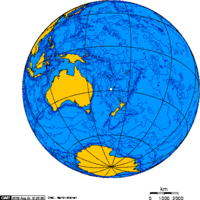Norfolk Island
Norfolk Island (167°57'E 29°02'S) lies in the South Pacific Ocean, 1,676 km north-east of Sydney, NSW. The Australian Territory of Norfolk Island covers 3,727 ha, and includes Norfolk, Phillip and Nepean islands.
The remnant of an elongated shield volcano which rose from the ocean 2.3 million to 3 million years ago, Norfolk Island is basically a plateau made up of horizontal sheets of basalt. The highest point, Mount Bates, climbs to 319 m above sea level. The islands of the territory perch on a shelf that is 95 km long, north to south, and 35 km wide, east to west.
Captain James Cook made first landfall on the island in 1774. Over the next 26 years, 40% of its natural vegetation was cleared and today only 5% of the native forest remains undisturbed. The island's symbol, the Norfolk pine, may grow taller than 60 m, with a girth of up to 11 m.
On Phillip Island, the introduction of rabbits led to the denuding of the island, which became a virtual desert. The rabbits were trapped out by 1986, however, and regeneration of the native vegetation is now rapidly taking place. The entire island is now part of Norfolk Island National Park, which covers 550 ha and also includes the Mount Pitt Section of Norfolk Island.
History
Signs of short periods of early occupation by Polynesian travellers have been found on Norfolk Island, but it entered recorded history on 10 October 1774. On that date, Captain James Cook, commanding the Resolution on his second voyage to the antipodes, claimed the island group for the British Empire.
Cook identified a number of resources that would be potentially useful to the British fleet – including Norfolk pine (for masts and spars) and native flax (for sailcloth) – and in 1788 the island was settled to exploit those resources. The settlers cleared large areas of native vegetation during the initial colonisation.
The failure of the settlement to become self-supporting and the difficulty and expense of maintaining the enterprise saw the original settlement finally abandoned in 1814. The buildings were destroyed to prevent unauthorised habitation of the territory, and the settlers were given land grants in Tasmania, in an area now known as New Norfolk, to compensate them for the loss of their farms on Norfolk Island.
In 1825 the island was again inhabited, this time as a convict settlement. It became a final place of punishment for recidivists and other British subjects considered antisocial, such as Irish political prisoners. The island became a centre of cruelty and degradation in human terms, but the island's natural ecosystem also suffered terribly, as the island was cleared to make way for buildings and large-scale agriculture. These dark days ended in 1855, when the last of the convicts were removed. By this time deportation of criminals had begun to lose popularity in England, and the colonial government had found better ways to use convict labour.
In 1856, however, the island finally became permanently inhabited by descendants of the Bounty mutineers. They had been living on remote Pitcairn Island, a British protectorate near French Polynesia, but decided to move to Norfolk Island when it was feared that Pitcairn would soon prove insufficient for their needs (the population was increasing rapidly and a landslide caused by a storm in 1845 had seen the desertion of the island's offshore fish population). The Pitcairn Island descendants now comprise around a third of the island's population of about 1,800, together with roughly equal numbers of settlers from Australia and New Zealand, and a small number of migrants from various other parts of the world.
During World War II an airfield was constructed on Norfolk Island to take advantage of its strategic location between the Coral Sea and air force bases in Australia and New Zealand. The airfield allowed increased access to the island in the postwar years, and the resulting tourism industry grew to become central to the island's economy.
References
- Department of the Environment, Heritage, Water and the Arts (Australia). 2008. "European history", Norfolk Island National Park. Retrieved 16 August 2008 from http://www.environment.gov.au/parks/norfolk/culture-history/european-history.html
- Department of the Environment, Heritage, Water and the Arts (Australia). 2008. "Norfolk Island National Park", Norfolk Island National Park. Retrieved 16 August 2008 from http://www.environment.gov.au/parks/norfolk/index.html
- Geoscience Australia. 2003. "Norfolk Island". Retrieved 16 August 2008 from http://www.ga.gov.au/education/facts/dimensions/externalterr/norfolk.htm
- Pitcairn Islands Office. n.d. "Pitcairn's history". Retrieved 16 August 2008 from http://www.government.pn/Pitcairnshistory.htm
